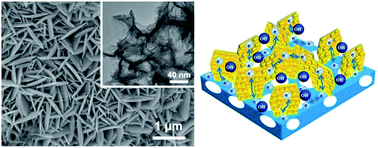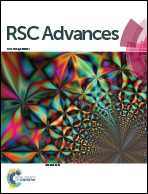Interconnected CuS nanowalls with rough surfaces grown on nickel foam as high-performance electrodes for supercapacitors†
Abstract
In this study, we have developed a facile in situ growth process to prepare three-dimensional (3D) interconnected CuS nanowalls on Ni foam, which have a large number of nanosheets on both sides of the nanowalls. The fabrication route contains the replacement process of Cu submicrometer-sized cubes on Ni foam and subsequent in situ growth process of interconnected rough CuS nanowalls (RCuS) on Ni foam via a hydrothermal method. The RCuS electrode displays excellent performance, demonstrating a specific capacitance of 1124 F g−1 at a current density of 15 mA cm−2 and 912.5 F g−1 at 30 mA cm−2 with a good cycling ability (∼90.7% of the initial specific capacitance remained after 2000 cycles), which is much higher than that of the CuS electrode through a simple hydrothermal (HCuS), taking copper dichloride as the copper source. The excellent electrochemical performance may be attributed to the high conductivity, large specific surface, and strong bonding between nanowalls and the Ni foam. The demonstrated high specific capacity and remarkable rate performance of the CuS nanowalls, together with the flexibility of the nickel foam substrate, make the 3D nanostructured electrode ideally suited for low-cost, high-performance supercapacitors.


 Please wait while we load your content...
Please wait while we load your content...